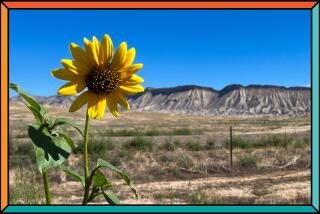AROUND HOME : Navajo Jewelry
- Share via
THE COLORS OF the desert sky and the magic landscape of the Southwest are reflected in the Navajo jewelry made of silver and turquoise. Because Navajo artisans made it primarily for their own and their family’s adornment and for religious ceremonies, each piece is unique.
From earliest days, the jewelry was fashioned with primitive tools. The artisans used a hand drill for turquoise, and silversmiths worked with the simplest of equipment. Today, techniques are much the same. The forge was a square structure of stones and adobe mud; the bellows were of sheepskin, and the anvil was simply a hard stone, later a piece of scrap metal from a plow or wagon. The mold for making casts was often a piece of volcanic tuff, a light pumice-like stone found on the reservation, and molds were greased with mutton tallow. Charcoal came from local pinon and juniper branches.
The art of making silver began in earnest soon after the tribe started life on the reservation, though it is probable that the Navajo had worked in metal as early as the 18th Century. By the 1880s, tribal artisans were mounting turquoise (found in mines near Santa Fe) in silver, often with the Spanish flair they had learned from the Mexicans. At first, the silver in dimes and quarters was used. When this was prohibited, the Mexican peso was used; later traders provided silver slugs and sheets of silver. The metal was hammered by hand, the silversmith singing as he worked.
Many of the designs were of Spanish origin, such as the squash blossom, which in reality is the pomegranate blossom. Typical artifacts include the naja (a crescent pendant hung from bridles), the ketoh (a wrist guard to protect from the snap of a bow string), buckles, bracelets, “squash-blossom” necklaces, rings, pins, earrings (worn by both men and women), buttons and special jewelry such as “mother-in-law” bells, powder horns and tobacco canteens and, of course, the popular concha belt discs.
All together this jewelry forms a Native American heritage of exquisite design, and it is sought after by collectors all over the country. United States cavalry officers in the 19th Century brought an enormous amount of Native American artifacts to the East, including Navajo blankets and jewelry. Today it is sometimes easier to find antique pieces in Massachusetts than in New Mexico.
One of the best sources for the finest in antique and contemporary Navajo jewelry is the Fairmont Trading Co. in South Pasadena, by appointment: (818) 796-3609. Some examples of Navajo work in its many forms may be found at the following: Silver Man Gallery West in Brentwood; Taos Indian Trading Co. and Hemisphere, both in Santa Monica; Native American Art Gallery in Venice; Ortega’s Capistrano Trading Post in San Juan Capistrano; Hopitu Indian Arts in La Jolla Shores, and American Indian Store and Apache Trading Post, both in San Diego.
More to Read
Sign up for Essential California
The most important California stories and recommendations in your inbox every morning.
You may occasionally receive promotional content from the Los Angeles Times.










